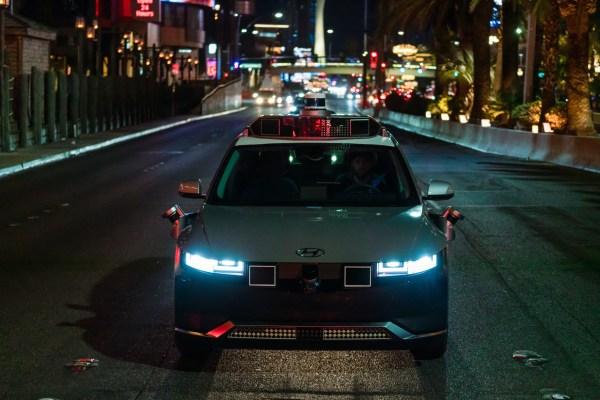Autonomous vehicle technology company Motional is moving one step closer to its goal of removing the safety driver from robotaxi operations by expanding its service in Las Vegas to nighttime rides.
Passengers in Vegas have been able to access Motional’s robotaxi service through ride-hail companies Lyft and Uber since August and December, respectively. The rides have been available during daytime hours and have always had a human safety operator in the front seat, but Motional is working towards a fully driverless service later this year.
Ashkay Jaising, Motional’s head of commercialization, told TechCrunch that the company had conducted extensive testing at night to validate the system and ensure that it performs as well at night as during the day.
Motional didn’t say specifically what hours its nighttime rides would be available, only referencing “peak hours” along “high-traffic Strip destinations.” The service is available Monday to Friday, according to the company. Motional has not yet started charging passengers for rides.
As part of the new launch, Motional has also connected its fleet of electric IONIQ 5 robotaxis to a Remote Vehicle Assistance (RVA) system to help the vehicles navigate obstacles or complex road scenarios. Motional’s vehicles fall under the category of Level 4 autonomy, meaning they can drive themselves in most cases within a specific operational design domain (ODD) and won’t need to be taken over by a driver. However, if something comes up that falls outside that ODD, the vehicle can ask for help.
In the past, Motional’s human safety operators would just take over driving when that happened. With the RVA system, a remote operator can guide the vehicle around an unfamiliar situation by, for example, drawing a new path for the vehicle to follow.
As Motional’s robotaxis drive more miles, the RVA will use machine learning to train and figure out solutions to new challenges, according to the company.
“As advanced as these vehicles are, and as many scenarios as they can handle, they will undoubtedly find themselves in some driving situation they’ve never experienced before,” said Greg Butron, a Motional engineer, in a statement. “RVA helps vehicles navigate complex conditions and continue their journey safely.”
This will help avoid a stalled vehicle waiting around for upwards of 30 minutes for a technician to come out and manually drive it off, said Jaising.
The launch of nighttime rides and the introduction of RVA are both steps toward Motional’s goal of going completely driverless later this year. In that vein, Motional will also feature an interface in the Uber and Lyft apps that gives passengers control over certain car functions, like unlocking the vehicle, starting the ride, contacting customer service and controlling the heat and A/C. In some rides, passengers can even preset the cabin temperature and adjust fan speed before the robotaxi picks them up.
“Down the road we want the vehicles to learn the personal preferences of our passengers, cabin temperature, lighting, maybe even music,” said Robert Agne, a product manager at Motional, in a statement. “We want them to feel like it’s more their own personal space.”
Testing the customer experience is a key part of Motional’s strategy for ensuring a smooth transition to driverless. Jaising said that even though there’s a safety driver in the vehicle, Motional is already providing a fully autonomous experience for riders.
“Meaning our systems and processes are designed to minimize interaction with the vehicle operators,” said Jaising. “When the vehicle arrives, passengers open the door through their app, they start the ride through an in-vehicle display, and can also contact a remote assistant for questions if needed.”
“This phase is an important part of our roadmap to offering a fully driverless service,” he continued. “We’re able to expose real riders to the driverless experience and refine our systems and processes based on rider feedback. This helps us ensure riders are comfortable interacting with the vehicle autonomously before we remove the operators.”
